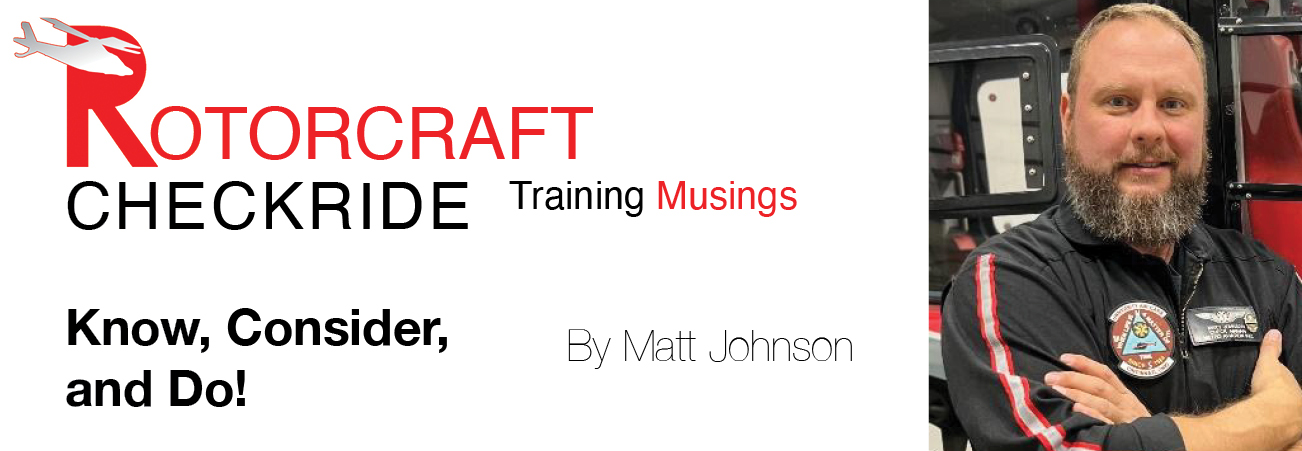|
Jun
26
2024
|
|
Posted 1 years 199 days ago ago by Admin
|
|

If you are a CFI or practical flight test applicant, those three words will become synonymous with you regarding how designated pilot examiners conduct practical exams. That is because it is finally here: the long-awaited Airman Certification Standards (ACS) go into effect on 31 May 2024. By the time you read this, I will have administered several practical tests under the new system, and most of the former Practical Test Standards (PTS) will be a thing of the past. While it will take some focused review by CFIs and updating of plans of action by DPEs, don't you fret! The ACS doesn't lengthen the practical test. Subjectively speaking, the ACS provides a much cleaner and clearer "flight plan," on the material the FAA expects you to know and for the skills you must demonstrate. In this latest release, the Helicopter ACS for Private, Instrument, Commercial, and CFI were published. For now, the Helicopter ATP will remain under the Practical Test Standards as well as the CFI-I.
For those unfamiliar, the ACS project started in 2011 as a means to improve pilot knowledge testing and practical evaluations. The FAA and industry partners sought a systematic approach that would provide explicit standards for aeronautical knowledge, list specific behaviors for risk management, consolidate overlapping tasks in the PTS, tie the many "special emphasis" items to knowledge and skill tasks, and finally, provide a means to connect the standards for knowledge, risk management, and skills to the guidance (FAA handbooks), to knowledge test questions, and to the practical tests. This is where those three words: “Know, Consider, and Do,” come into play. For any given task, the ACS specifically lists “Know” by outlining what knowledge an applicant must understand. "Consider" deals with aeronautical decision making and special emphasis items, collectively compiled into the risk management portion. Finally, "Do" relates to the actual skills that the applicant must do by demonstrating the ability to carry out various skill-related tasks, such as performing a maneuver within published standards, computing performance information, etc.
Our fixed-wing brethren transitioned to the ACS for some of their practical tests in 2016 with the change to their Airplane Private, Instrument, and Commercial testing standards, and they now finally have their CFI and ATP ACS in this latest release as well. This change came after years of tireless work in improving training, testing, and proficiency standards by the Aviation Rulemaking Advisory Committee's Airman Certification Standards Working Group. One of the many professionals who serve on that working group is none other than Robinson Helicopter icon Tim Tucker. He has conducted over 8,500 practical tests during his 40-year DPE tenure. Using his unparalleled experience and expertise, Tucker and others poured countless hours into the project, and some of the needed changes made it into this first iteration of the various Helicopter Airman Certification Standards. In a recent discussion with Tucker regarding his work on the ACS Working Group, he explained that the new ACS "does a lot of things to improve the testing environment. Standards drive the handbooks, thus improving the overall information presented in the various FAA Handbooks.” he explained. "The helicopter community must be aware that each task is much more comprehensive now." With the reading of each ACS (more times than I care to admit), I noticed the more detailed information for each task and applaud Tucker and his working-group colleagues for their efforts. In addition to the more comprehensive tasks, you will see entirely new additions as well. One such addition for the Commercial ACS is a task dedicated to "Flight Solely by Reference to Instruments" and a task for "Recovery from Unusual Flight Attitudes." I am hopeful they will be able to push even more positive changes in future iterations of the various ACS.
Since the announcement of the effective date of the various Airman Certification Standards, many have questioned what a CFI can do to become more familiar with new Airman Certification Standards. There is no magic answer other than simply taking the time to read each standard in its entirety. One of the things you will notice while reading the cleaner format is that the ACS assigns a unique code to each knowledge, risk management, and skill task element. These codes provide the means to correlate the tasks in the ACS with guidance and testing at a much more detailed level by providing a single-source set of standards for both the knowledge exam and the practical test. As an example, let's take a look at what code “PH.I.F.K5” means: PH = Private Pilot Helicopter (defines applicable ACS) I = Preflight Preparation (defines Area of Operation) F = (defines Task) K5= Height/Velocity (H/V) diagram according to the Rotorcraft Flight Manual defines Element.
Like any change, it will take time to fully appreciate the numerous benefits of this new way of doing things, but from the early onset, I like what I see.
About the Author: Matt Johnson has been an FAA designated pilot examiner for over a decade, conducting exams ranging from Private to ATP and CFI. Additionally, he is a single-pilot IFR air medical captain and Part 135 instructor and check airman. He can be reached at [email protected] and via Twitter @HelicopterDPE
YouTube Channel: https://www.youtube.com/channel/UCt4y..
READ MORE ROTOR PRO: https://justhelicopters.com/Magazine
WATCH ROTOR PRO YOUTUBE CHANNEL: https://buff.ly/3Md0T3y
You can also find us on
Instagram - https://www.instagram.com/rotorpro1
Facebook - https://www.facebook.com/rotorpro1
Twitter - https://twitter.com/justhelicopters
LinkedIn - https://www.linkedin.com/company/rotorpro1